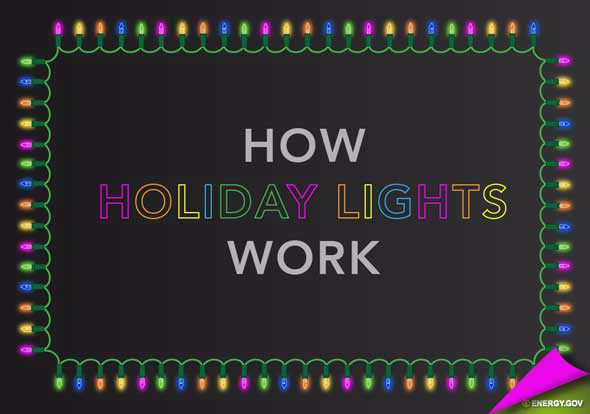
Holiday lights are a great way to learn about the flow of electric current. In a simple circuit, including one in an incandescent light bulb, electricity travels through a closed circuit, passing over a filament, causing it to glow brightly.
The more current that passes over a filament, the hotter it will get, the brighter it will burn, and the quicker it will burn out. If the circuit is broken, or open, no electricity will pass over the filament and it will not light. If the current is too great, the filament will melt, or blow out, causing the circuit to become open.
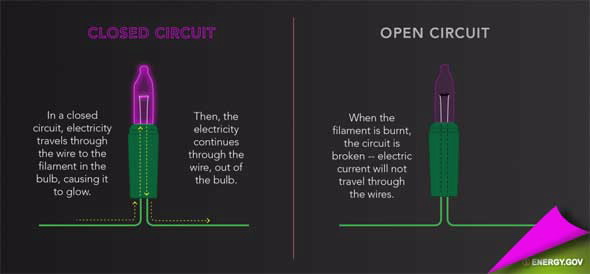
But we want more than one light to shine on our Christmas tree or along the roofs of our homes. If you want to connect multiple light bulbs to the same power source, there are two ways to do that: either attach the lights in series or in parallel.
Parallel vs Series Light
When lights are attached in series, the electricity passes from the power source to the first light, and then from light to light until it returns to the power source. In this setup, when a filament within any one bulb blows out, it creates an open circuit in the wiring. As mentioned earlier, when a circuit is incomplete, or open, electricity fails to pass through any of the wire, causing all the lights to go out.
When lights are attached in parallel, each light is on its own circuit to the power source. If one filament burns out, it has no effect on the remaining lights, as they each continue to be in a closed circuit with the power source. See the difference below.
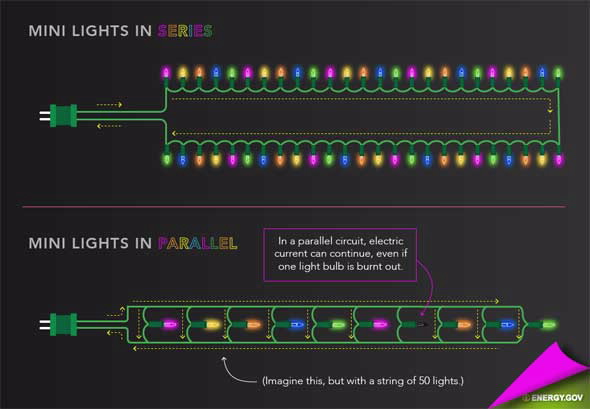
With strings of holiday lights, engineers decided that the best option was to connect several series of lights together in parallel. In other words, holiday lights are both in series and in parallel.
This way, when one series of bulbs becomes defective -- say, from a loose bulb -- it should have no effect on any of the other series of bulbs, since they are in parallel to the defective series. This is why sometimes only one portion of your lights will become defective, while others will remain functional. When additional strings of lights are attached to the end of a string, these lights are added in parallel to the original strand.
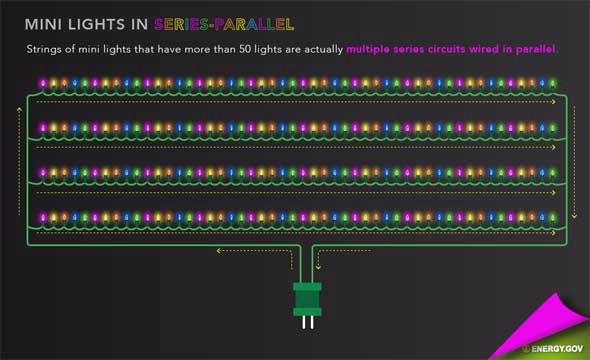
But what about when a bulb goes out in a series? It used to be that when one bulb went out, the entire series would go out. If this were the case, you would have to check each bulb individually to see which one was blown out. If multiple bulbs were blown out, this would become exceedingly difficult. The shunt solved this problem.
Shunts and fuses save the day
A shunt is any device that allows current to continue flowing through a circuit by creating a path of lower resistance than the original path. In incandescent holiday lights, shunts are small wires wrapped beneath the filament. Initially, they are coated with a substance that makes them an insulator.
In other words, electricity cannot pass across the shunt as long as the filament exists, because the coating gives the shunt a higher resistance initially than the filament, and the electrical current avoids the shunt in order to find the path of least resistance through the filament.
If the filament burns out, however, the high temperature from the burnout will cause the substance coating the shunt to melt off, revealing the lower resistance wire beneath. Now the shunt has gone from an insulator to a conductor, and current passes along shunt, keeping the circuit closed, and the remaining lights burning. See below.
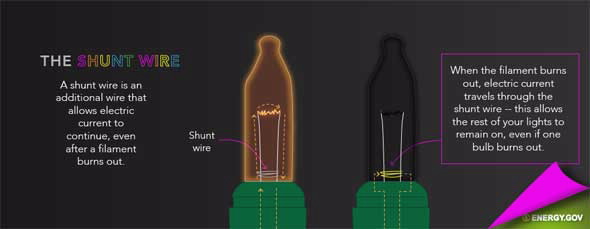
While shunts serve to remedy an open circuit, fuses work to prevent damage due to a short circuit or any other dramatic increase in current. A short circuit is the opposite of an open current. In other words, a short circuit is caused when electrical current finds an unintended path of lower resistance.
At a steady voltage, this causes a spike in current, which can cause a variety of problems -- some mild (increased rate of incandescent bulb burnout) and some severe (system overheating and fires).
Fuses are important safety features for many electrical appliances, but most of us don't even know that they're there. In holiday lights, the fuse can be found near the part of the strand that plugs into the wall, often called the male end of the wire. Normally, the fuse is accessible through a small plastic door in the plug that can be opened and closed for replacing the fuse.
As the electrical current within a wire increases, the wire can heat up, at times causing melting or even fires. To prevent this, fuses were introduced as so-called “sacrificial devices”. When the current increases past a safe level, instead of the wire melting or your Christmas tree catching fire, the fuse safely opens the circuit, averting many disastrous scenarios.
Fuses are typically small sections of replaceable wire, rated to a maximum current level. Because they are more delicate than the rest of the wiring, a fuse will burn out before overcurrent has an opportunity to overheat other portions of the light strand. When a fuse breaks, the circuit becomes incomplete and current cannot flow through the remainder of the circuit.
What about LED holiday lights?
LED holiday light strands are becoming more popular. They’re sturdier, last longer and consume 70 percent less energy than conventional incandescent light strands. On top of that, they are significantly less likely to burn out or break compared to their incandescent forerunners. Why is this?
While incandescent light technology is relatively straightforward (a heated filament glows much like any ember in a fire), the mechanics of LED lights are much more sophisticated. It requires a bit of insight into particle physics to understand. A diode consists of something called a p-n junction -- two semiconductor materials next to each other, one with a positive charge (p) and one with a negative charge (n).
When current is applied to the system, electrons from the negative side move toward the positive side. On the positive side, particles called “electron holes” move toward the negative side. When an electron and an electron hole collide, a small amount of energy is released as a photon. The result is the visible light we see in an LED.
LEDs are wired in series-parallel just like the traditional bulbs we described above. Unlike incandescent lights, however, LEDs do not typically make use of shunts. When incandescent light bulbs fail, the missing filament causes an open circuit -- a drastic increase in resistance too high for the current to pass across. On the other hand, when an LED fails, it typically short circuits, creating a path of lesser resistance. This essentially takes the place of a shunt, making shunts unnecessary for LEDs.
Best wishes for the holidays.
Reprinted with permission of the US Energy Department www.energy.gov
Published: 21/12/2015


